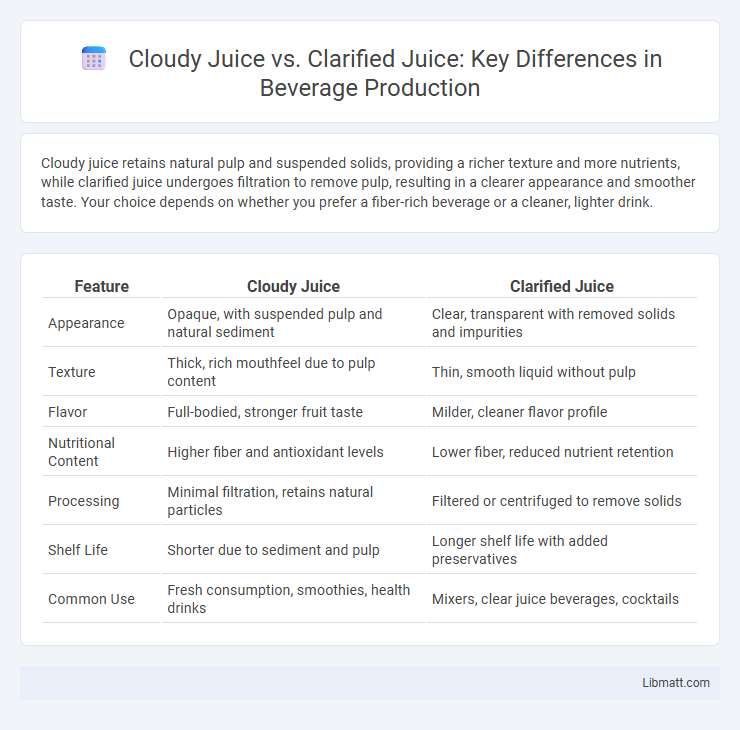Cloudy juice retains natural pulp and suspended solids, providing a richer texture and more nutrients, while clarified juice undergoes filtration to remove pulp, resulting in a clearer appearance and smoother taste. Your choice depends on whether you prefer a fiber-rich beverage or a cleaner, lighter drink.
Table of Comparison
| Feature | Cloudy Juice | Clarified Juice |
|---|---|---|
| Appearance | Opaque, with suspended pulp and natural sediment | Clear, transparent with removed solids and impurities |
| Texture | Thick, rich mouthfeel due to pulp content | Thin, smooth liquid without pulp |
| Flavor | Full-bodied, stronger fruit taste | Milder, cleaner flavor profile |
| Nutritional Content | Higher fiber and antioxidant levels | Lower fiber, reduced nutrient retention |
| Processing | Minimal filtration, retains natural particles | Filtered or centrifuged to remove solids |
| Shelf Life | Shorter due to sediment and pulp | Longer shelf life with added preservatives |
| Common Use | Fresh consumption, smoothies, health drinks | Mixers, clear juice beverages, cocktails |
Introduction to Cloudy and Clarified Juice
Cloudy juice contains natural pulp and suspended solids, preserving more fiber, vitamins, and antioxidants than clarified juice, which undergoes filtration to remove these components for a clearer appearance and smoother texture. The cloudy variety tends to have a richer taste and higher nutritional value, while clarified juice offers improved shelf life and visual appeal. Both types serve different consumer preferences, with cloudy juice favored for its wholesomeness and clarified juice preferred for its clarity and ease of digestion.
Defining Cloudy Juice
Cloudy juice contains suspended pulp and natural solids that retain more vitamins, fiber, and antioxidants compared to clarified juice, which is filtered to remove these particles and achieve a clear, translucent appearance. The cloudiness in cloudy juice results from tiny juice particles and natural compounds that contribute to a richer flavor and enhanced nutritional value. This unfiltered nature makes cloudy juice a preferred choice for consumers seeking a more natural and nutrient-dense beverage.
Defining Clarified Juice
Clarified juice is a type of fruit juice that has undergone a filtration process to remove pulp, solids, and suspended particles, resulting in a clear and visually appealing liquid. Unlike cloudy juice, which retains natural fibers and sediments giving it a thicker texture and opaque appearance, clarified juice offers improved shelf stability and a smoother mouthfeel. This processing method is commonly used in beverage production to achieve uniformity and enhance the presentation of fruit-based products.
Differences in Appearance
Cloudy juice has a hazy, opaque appearance due to suspended solids such as pulp and natural fibers, giving it a thicker texture and richer mouthfeel. Clarified juice appears clear or translucent because these solids are removed through filtration or centrifugation, resulting in a lighter, more transparent liquid. The visual difference between cloudy and clarified juice is a key factor in consumer preference, often signaling naturalness for cloudy juice versus purity for clarified juice.
Nutritional Content Comparison
Cloudy juice retains more natural vitamins, minerals, and antioxidants due to minimal filtration, resulting in higher fiber content and enhanced nutritional value compared to clarified juice. Clarified juice undergoes processes that remove pulp and sediment, reducing its levels of dietary fiber and some phytonutrients. This difference makes cloudy juice a richer source of essential nutrients beneficial for digestion and overall health.
Flavor and Aroma Profiles
Cloudy juice offers a richer and more complex flavor profile due to the presence of pulp and natural sediments, which contribute to a fuller mouthfeel and intensified fruity aromas. Clarified juice, on the other hand, provides a cleaner, smoother taste with a lighter aroma as most solids are removed during filtration, resulting in a more refined but less robust sensory experience. The choice between cloudy and clarified juice often depends on desired intensity, with cloudy juice favored for boldness and clarified juice preferred for subtlety.
Health Benefits of Cloudy vs Clarified Juice
Cloudy juice retains more natural fibers, antioxidants, and vitamins like vitamin C and polyphenols, which contribute to improved digestion, boosted immune function, and reduced risk of chronic diseases. Clarified juice undergoes filtration that removes pulp and sediments, resulting in lower fiber content and reduced levels of some antioxidants, but it remains a quick source of hydration and essential nutrients. Choosing cloudy juice supports gut health and antioxidant intake more effectively compared to clarified juice.
Production and Processing Methods
Cloudy juice is produced by minimal processing, retaining pulp, fibers, and suspended solids through gentle pressing or blending, which preserves natural flavor and nutrients. Clarified juice undergoes filtration techniques such as centrifugation, fining, or membrane filtration to remove solids and achieve a clear, transparent appearance. The choice of production method affects texture, shelf life, and sensory properties, with cloudy juice offering a thicker mouthfeel and clarified juice providing a smooth, sediment-free beverage.
Culinary and Beverage Applications
Cloudy juice retains pulp and natural solids, providing a richer texture and more intense flavor ideal for smoothies, sauces, and craft cocktails where mouthfeel and natural appearance are desired. Clarified juice undergoes filtration to remove solids, resulting in a clear, bright liquid perfect for fine dining beverages, refined sauces, and cocktails requiring visual clarity. The choice between cloudy and clarified juice directly impacts the texture, flavor profile, and presentation in culinary and beverage applications.
Consumer Preferences and Market Trends
Cloudy juice retains natural pulp and fiber, appealing to consumers seeking wholesome, nutrient-rich beverages, while clarified juice offers a smoother texture favored for its refined taste and longer shelf life. Market trends show growing demand for cloudy juice driven by health-conscious buyers prioritizing antioxidants and vitamins, whereas clarified juice remains popular in premium and convenience sectors due to its clarity and consistent flavor. Your choice depends on preference for texture and nutritional content, as both types cater to distinct segments within the competitive juice market.
Cloudy juice vs clarified juice Infographic

 libmatt.com
libmatt.com